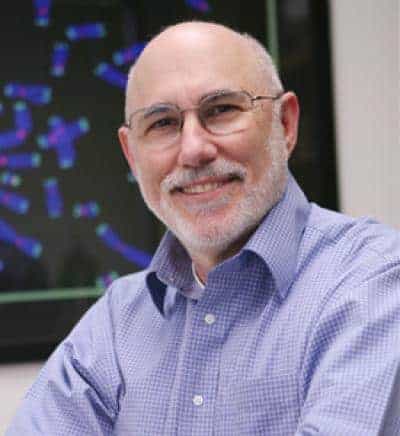UT Southwestern Medical Center researchers are developing a new predictive tool that could help patients with breast cancer and certain lung cancers decide whether follow-up treatments are likely to help.
Dr. Jerry Shay, Vice Chairman and Professor of Cell Biology at UT Southwestern, led a three-year study on the effects of irradiation in a lung cancer-susceptible mouse model. When his team looked at gene expression changes in the mice, then applied them to humans with early stage cancer, the results revealed a breakdown of which patients have a high or low chance of survival.
The findings, published online in Clinical Cancer Research, offer insight into helping patients assess treatment risk. Radiation therapy and chemotherapy that can destroy tumors also can damage surrounding healthy tissue. So with an appropriate test, patients could avoid getting additional radiation or chemotherapy treatment they may not need, Dr. Shay said.
“This finding could be relevant to the many thousands of individuals affected by these cancers and could prevent unnecessary therapy,” said Dr. Shay, Associate Director for Education and Training for the Harold C. Simmons Comprehensive Cancer Center at UT Southwestern. “We’re trying to find better prognostic indicators of outcomes so that only patients who will benefit from additional therapy receive it.”
Dr. Shay’s study closely monitored lung cancer development in mice after irradiation. His group found some types of irradiation resulted in an increase in invasive, more malignant tumors. He examined the gene expression changes in mice well before some of them developed advanced cancers. The genes in the mouse that correlated with poor outcomes were then matched with human genes. When Dr. Shay’s team compared the predictive signatures from the mice with more than 700 human cancer patient signatures, the overall survivability of the patients correlated with his predictive signature in the mice. Thus, the classifier that predicted invasive cancer in mice also predicted poor outcomes in humans.
His study looked at adenocarcinoma, a type of lung cancer in the air sacks that afflicts both smokers and non-smokers. The findings also predicted overall survival in patients with early-stage breast cancer and thus offer the same helpful information to breast cancer patients; however the genes were not predictive of another type of lung cancer, called squamous cell carcinoma. Other types of cancers have yet to be tested.
The American Cancer Society estimates the risk of developing lung cancer to be 1 in 13 for men and 1 in 16 for women, including both smokers and non-smokers. Lung cancer is the second most common cancer in both men and women, accounting for about 13 percent of all new cancers, and about 27 percent of cancer deaths. The American Cancer Society estimates more than 224,210 new cases of lung cancer and nearly 160,000 deaths from lung cancer will occur in 2014. Survival statistics vary depending on the stage of the cancer and when it is diagnosed.
Dr. Shay’s research is paid for in part by a five-year grant from NASA, which helps fund cancer research due to cancer risks faced by astronauts during space missions. The findings could lead to more individualized care and pave the way to better, more science-based care and decision making, he said.
“Personalized medicine is coming,” Dr. Shay said. “I think this is the future – patients looking at their risks of cancer recurrence and deciding what to do next. We can better tailor the treatment to fit the individual. That’s the goal.”


